
Mimosa flower tincture is a real treat come late spring and early summer. This year, the summer months are full to bursting with nature’s bounty to the point that my garden is producing more vegetables than my husband and I can eat, the yard is overrun with flowers, and the trees are in full bloom. The din of early flying bees is quite mesmerizing!
One tree, in particular, I’m excited about is our mimosa tree. Since buying our house, we have waited patiently for it to bloom. Well, my friends, July, it seems, is the time!
This amazing tree, with its copious pollen and valuable nectar source, attracts dozens of hummingbirds, butterflies, and other beneficial pollinators and friendly insects during its blooming period.
If you live anywhere in the milder regions throughout the US, you may have spotted these pink tufted trees with fern-like leaves on your daily commute. They're actually considered quite invasive and will sprout thousands of seedlings a year with ease.
And, as with many invasive plants, they're quite medicinal!
So today, we're going to learn how use its flowers in an incredibly calming tincture recipe.
How to Make Mimosa Flower Tincture and What It’s Good For
Not only is mimosa in full bloom beautiful to look at, it's also a wonderful remedy that has been used in traditional Chinese medicine for hundreds of years.
Known as "He Huan Pi," or, "the happiness herb," mimosa is well-known for its capacity to "anchor the heart." This means that it can assist in stabilizing emotions, inducing a mild sense of tranquility in the mind, and providing relief for individuals dealing with anxiety, insomnia, symptoms of post-traumatic stress disorder, and panic.
Mimosa blossoms have also been used for:
- Depression
- Adrenal fatigue
- Balancing emotional sensitivity and melancholy
- Promoting a sense of calm and relaxation
- Supporting healthy sleep
- treating symptoms of sore throat
- Supporting healthy memory function
- Lightening a heavy heart
- PTSD
Since most of us deal with some level of stress on a daily basis it’s good to know about a few natural ways to help mitigate its effects.
More and more we are learning about just how much stress negatively affects the body and mind, and now, more than ever, it’s important for us to strive for a more calming atmosphere in our lives.
One way to do that is by taking mimosa tincture, and right now, the trees are ripe for the picking.
Mimosa, aka Albizia julibrissin, is one of the most valued botanicals in Chinese medicine for supporting an uplifted mood and peaceful state of mind. Known as the “herb of happiness”, Mimosa helps encourage mental stability and promotes emotional serenity.
I don’t know about you, but that sounds great! I could really use a bit more “emotional serenity” in my life.
Mimosa blossoms are also good for encouraging restful sleep, calming the spirit, relieving emotional constraint associated with anger, soothing irritability, and improving cognitive function. Mimosa bark is also a potent ally for grief and heartbreak because it helps anchor the heart and stabilize emotions.
I like to use mimosa flower tincture when I feel like I’m stuck in an angry and brooding sort of mood because it helps dissipate those unnecessary, damaging, and circulating thoughts from my mind and instead instills a sense of calm and control.
As soon as my tree was full of pink fluffy blossoms, I went out with a jar in hand and started picking them for tincturing.
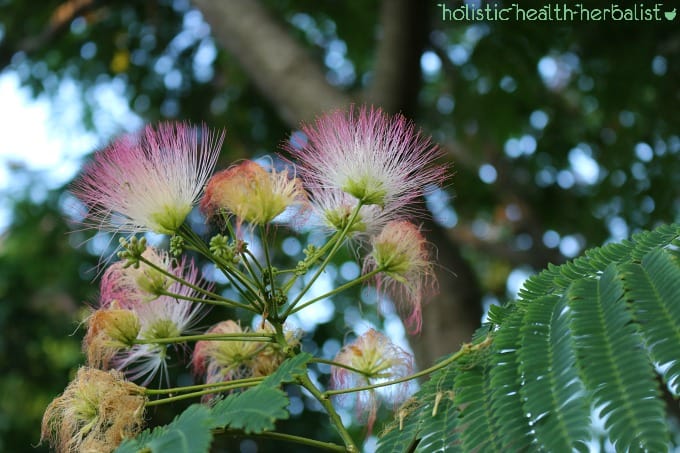
My mimosa tree is FULL of mimosa flowers!
Mimosa Blossom Tincture Recipe
The Folk Method
I typically use the folk method when making my tinctures which you can learn more about, in depth, here.
To make mimosa tree flower tincture, all you will need are:
- Fresh mimosa blossoms
- A jar
- 80 proof Vodka
Pick the mimosa blossoms and check them for tiny bugs, caterpillars, and debris. Make sure you remove the long green stems from the blossoms before adding them to the jar.
Fill the far until full with blossoms but not tightly packed.
Next, cover the blossoms with 80 proof vodka making sure they are completely submerged. You may need to top off the jar again the next day depending on how much alcohol the flowers soak up.
Label and date the jar, then store it in a cool dark place for 4-6 weeks.
Make sure to gently shake the mimosa tincture on occasion during this time to agitate the contents.
Once 4-6 weeks have passed, strain the tincture and bottle it. Make sure to label your bottles with the name of the herb, its botanical name, the date, the uses of the herb, and the dosage.
This tincture will keep indefinitely if stored in a cool dark place.
To use, take ¼ teaspoon (1 dropperful) of mimosa tincture in a little bit of water up to five times daily to help support a positive mood and mental calm.
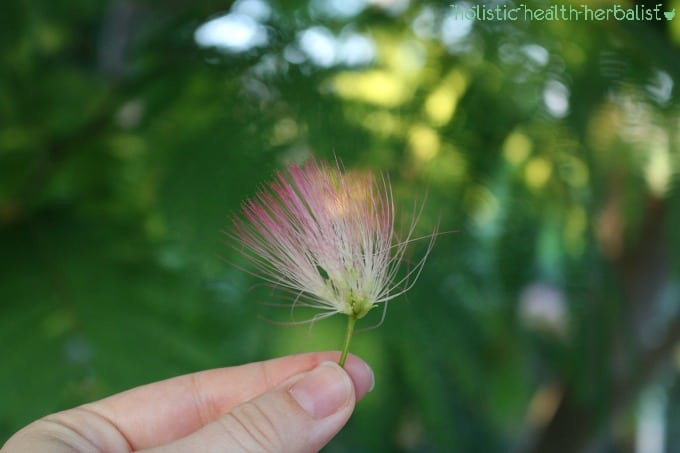
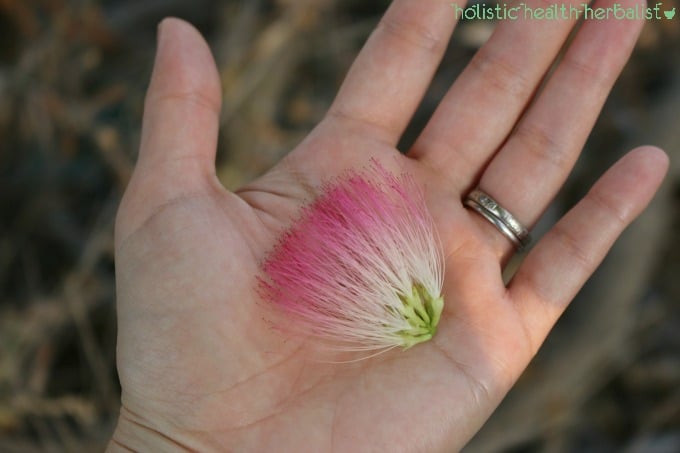
The pink mimosa flower is so beautiful to look at!
The Weight and Volume Method
If you want to get more precise, you can make mimosa tincture by weighing out the blossoms and then using the appropriate proportion of alcohol.
To make mimosa tincture using fresh blossoms, you will need to use a 1:2 ratio of blossoms to alcohol.
For example, if you picked 1 ounce of mimosa blossoms, you would use 2 ounces of alcohol.
If you picked 4 ounces of mimosa blossoms, you would need 8 ounces of alcohol, and so on.
Use a kitchen scale to determine the weight of your blossoms, then measure out how much 80 proof vodka you would need.
Add everything to a jar and allow it to macerate for 4-6 weeks before straining and bottling.
You can use 1-2 dropperfuls of this tincture up to 3 times daily.
To make a tincture with dried mimosa flowers using the weight and volume method, you would use a 1:5 ratio.
For example, if you used 1 ounce of dried mimosa blossoms, you would use 5 ounces of 80 proof vodka.
If you used 4 ounces of dried blossoms, you would use 20 ounces of 80 proof vodka.
Add everything to a jar and let it macerate for 4-6 weeks before straining and bottling.
You can use 1-2 dropperfuls of this tincture up to 3 times daily.
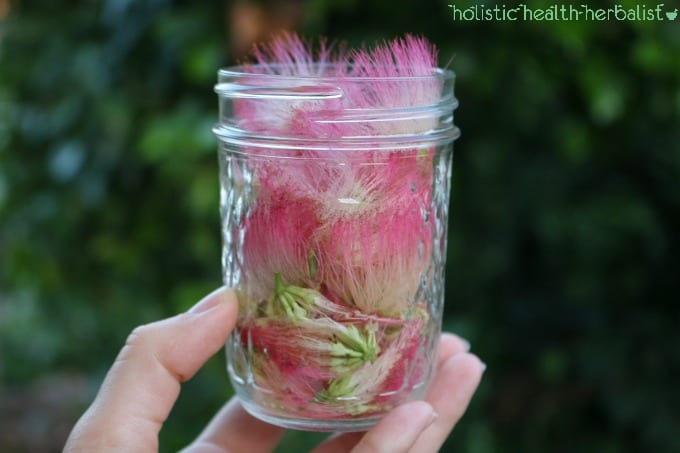
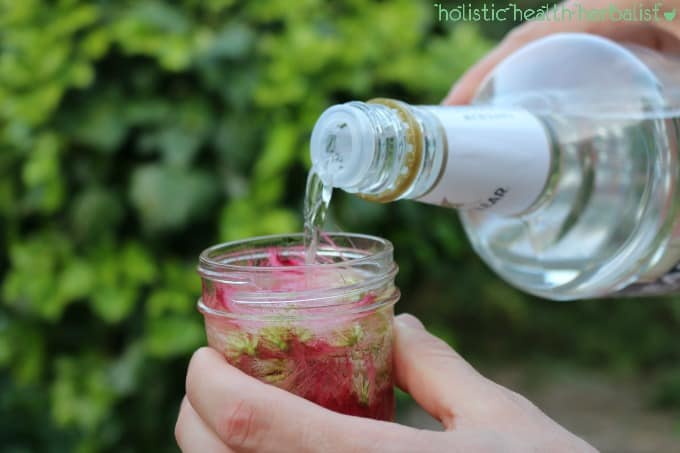
Mimosa Tincture Benefits
The many benefits of mimosa tincture include:
- Treating insomnia
- Helping you fall asleep, stay asleep, and supports restful sleep
- Reduce stress and tension
- Ease strong emotions - especially those related to grief and depression
- Uplifts a dark and sour mood
- Gives you a sense of calm and emotional balance (this is perfect for tough stay-at-home-mom days!)
- It's giddiness in a bottle!
The mimosa flower is quite versatile when it comes to emotional support.
Precautions for Mimosa Flower Tincture
Do not take mimosa flower tincture if you are pregnant, nursing, or taking antidepressants.
Frequently Asked Questions about Mimosa Flowers
Are mimosa flowers edible?
Yes, mimosa flowers are edible and can be eaten fresh or cooked into dishes like stir fry, soups, and stews. They have a sweet and floral flavor.
Mimosa flower tea is an especially calming drink to enjoy after a long and stressful day.
When does mimosa flower in the uk?
Blooms will begin to appear in late spring or early summer and are one of the few trees left still in bloom when all others have stopped. They have a soft and sweet fragrance.
How to dry mimosa flowers?
Pick the fresh mimosa flowers at their peak and lay them out in a single layer on parchment paper or paper towels. Allow them to air dry in a cool dark place for a few days making sure to gently flip the flowers midway through the drying process.
Make sure they are completely dry before storing in an airtight container to prevent the growth of mold.
Dried flowers can be used as a tea or made into a tincture.
When does mimosa flower?
Mimosa trees begin to flower in late spring and early summer. The Acacia dealbata variety (with yellow flowers) will bloom in early spring.
Where to buy mimosa flowers?
You can often find dries pink mimosa flowers on ebay, but for freshness purposes, I encourage you to correctly identify and harvest the flowers yourself.
What is a Mimosa flower?
A mimosa flower is the flower of Albizia julibrissin (aka the Persian silk tree or pink silk tree) of the fabaceae family. These trees grow everywhere from temperate areas of north america to areas of europe like Italy, France, and the UK. It can even be found in Australia and Africa - basically anywhere where with milder weather conditions.
The flowers resemble a pink and white spray of fireworks and have a lightly sweet and floral aroma.
These magnificent trees bloom in late spring to early summer and the mimosa herb (the pink flowers) should be collected in the morning after they bloom for the highest quality.
What are Mimosa blossoms good for?
Mimosa blossoms, also known in TCM as "happiness herb" or "collective happiness bark" (both flowers and bark is used), is good for all manner of emotional imbalance like grief, sadness, a heavy heart, anxiety, insomnia, and feelings of hopelessness.
What do Mimosa flowers smell like?
Mimosa flowers have a light, sweet, slightly floral fragrance with an almost cucumber-y undertone.
Why is Mimosa called touch-me-not plant?
Mimosa pudica (which is different than Albizia julibrissin) is a type of mimosa that reacts to touch by closing its leaves.
What do mimosa flowers smell like?
Pink Mimosa flowers have a light floral almost cucumber-like aroma.
How do you grow a mimosa tree?
Sow a single mimosa seed in a 3x3 pot in a sheltered site (with full sun) away from strong wind or danger of frosts or cold weather (a greenhouse works well!). The soil should provide adequate drainage and there should be several drainage holes in the bottom of the pot.
Water daily to keep the soil moist until germination. You will notice that the seedlings are very fast growing and will develop true leaves within a matter of days.
Once the true leaves have come in, you can transplant the baby tree into a large container, topped with plenty of well-rotted compost. Place the container in a nice sunny spot. The tree may begin blooming its first year if conditions are favorable and will offer a spectacular sight year after year with eye-catching pom-pom blooms and stunning grey green filigree foliage.
Check the bottom of the pot a few times per year to ensure that the root ball is healthy. Once the tree has reached a few feet in height, it will be safe to transplant it from its large plant pot into the outdoor garden. Sunny courtyards are a lovely place for a mimosa tree, but they will do well even in a small garden (they even do well on the roadside with poor soil conditions!).
Once mature, mimosa trees will reach about 12 meters tall (about 40 feet) and live up to 20 years.
They are resistant to most pests, are drought-resistant, and are winter hardy as long as there is no risk of severe frost in your area. If provided a lot of sunshine, this humble plant makes for a handsome year-round feature everywhere from the sunny corners of a room and small patios to the grand British garden.
What are the mimosa tree medicinal benefits?
The Mimosas flower is used medicinally for:
- Grief
- Depression
- Insomnia
- PTSD
- Emotional trauma
- Calming and lifting the spirit and emotions
- Helps heal joint and connective tissue injuries
- Lessens pain, swelling, and inflammation
One of my personal favorite mimosa tree benefits is how it uplifts even the darkest mood.
When do mimosa trees bloom?
mimosa trees bloom from late spring into early summer. Here in zone 10a, my mimosa tree is blooming around mid-July.
How long does a mimosa tree live?
A healthy mimosa tree will live 15-20 years.
Have you ever made or used mimosa tincture? Please share in the comments below!
You may also enjoy reading:
"Collecting Happiness" with Mimosa
Mimosa “Full Happiness” Flowers
The Magic of Mimosa: Cordial and Tincture Recipes
Pedicularis Tincture for The Side Effects of Stress






Leave a Reply